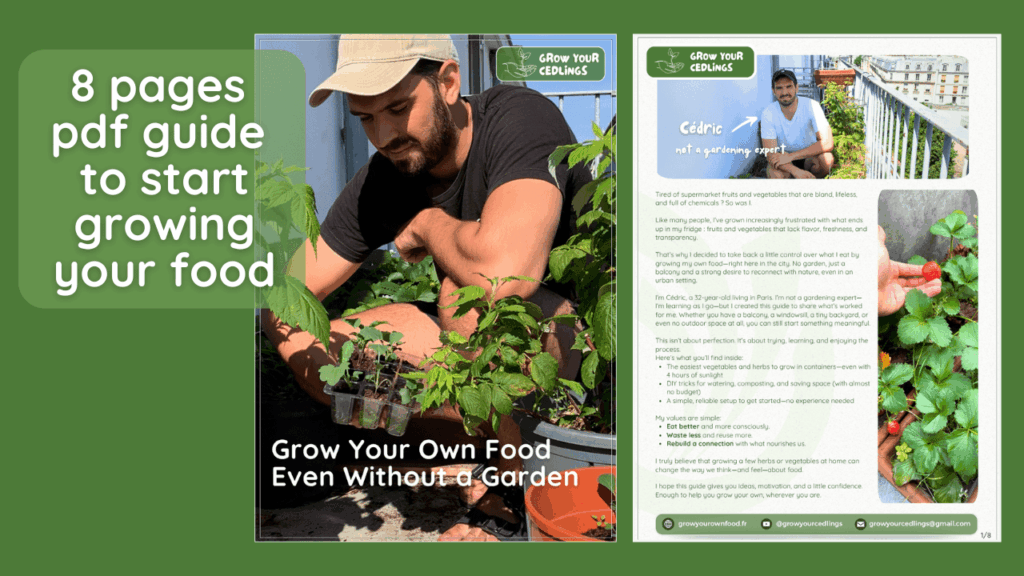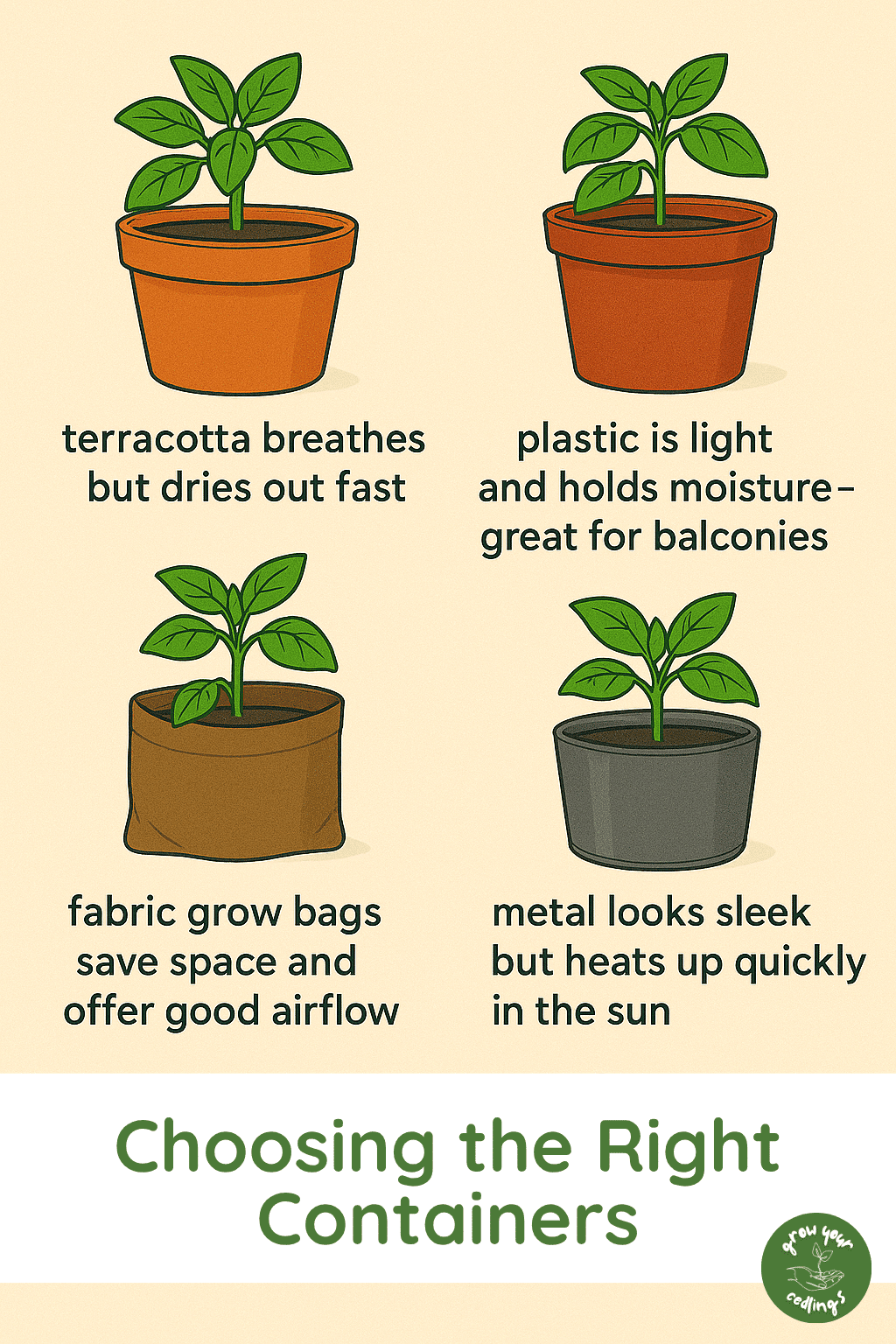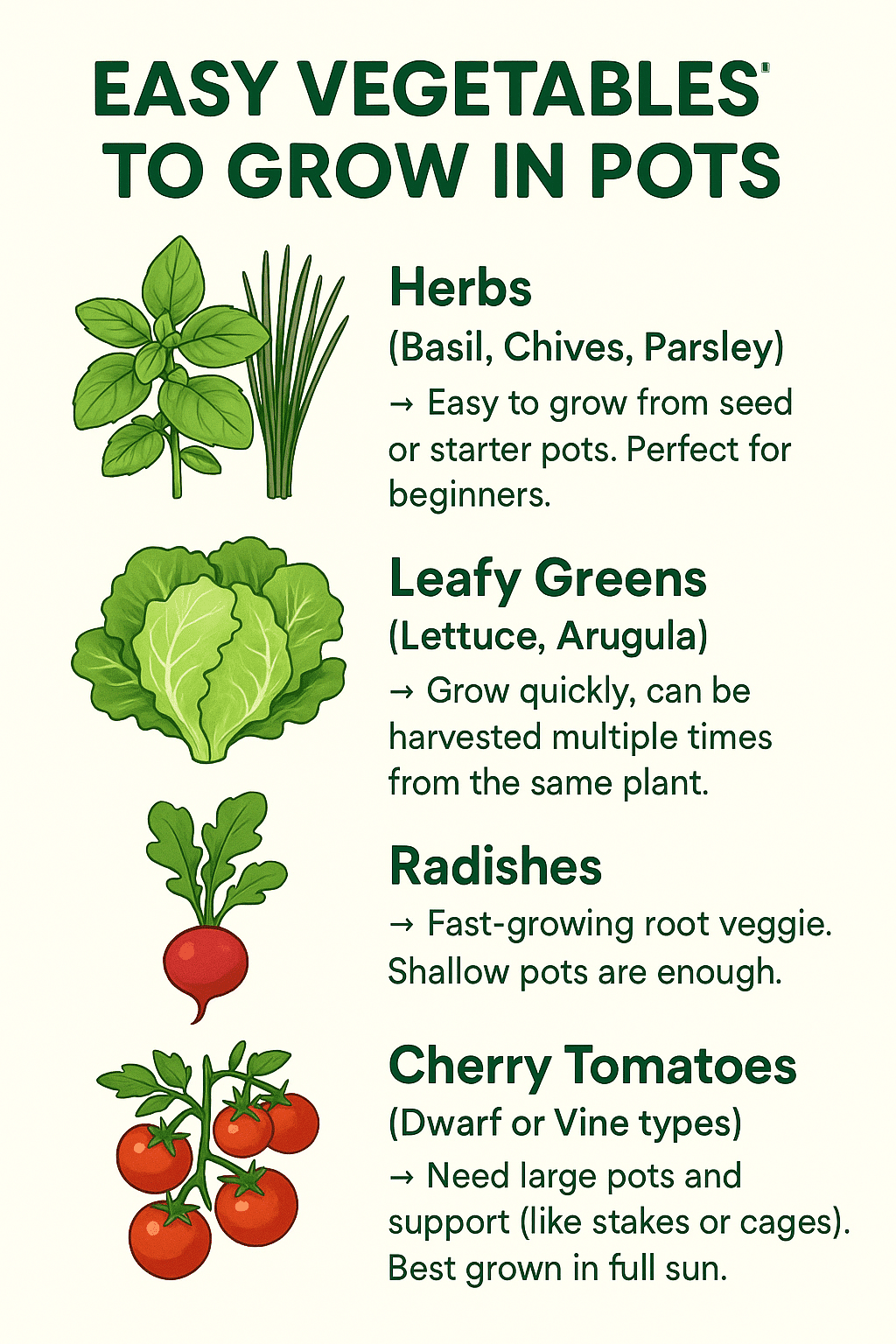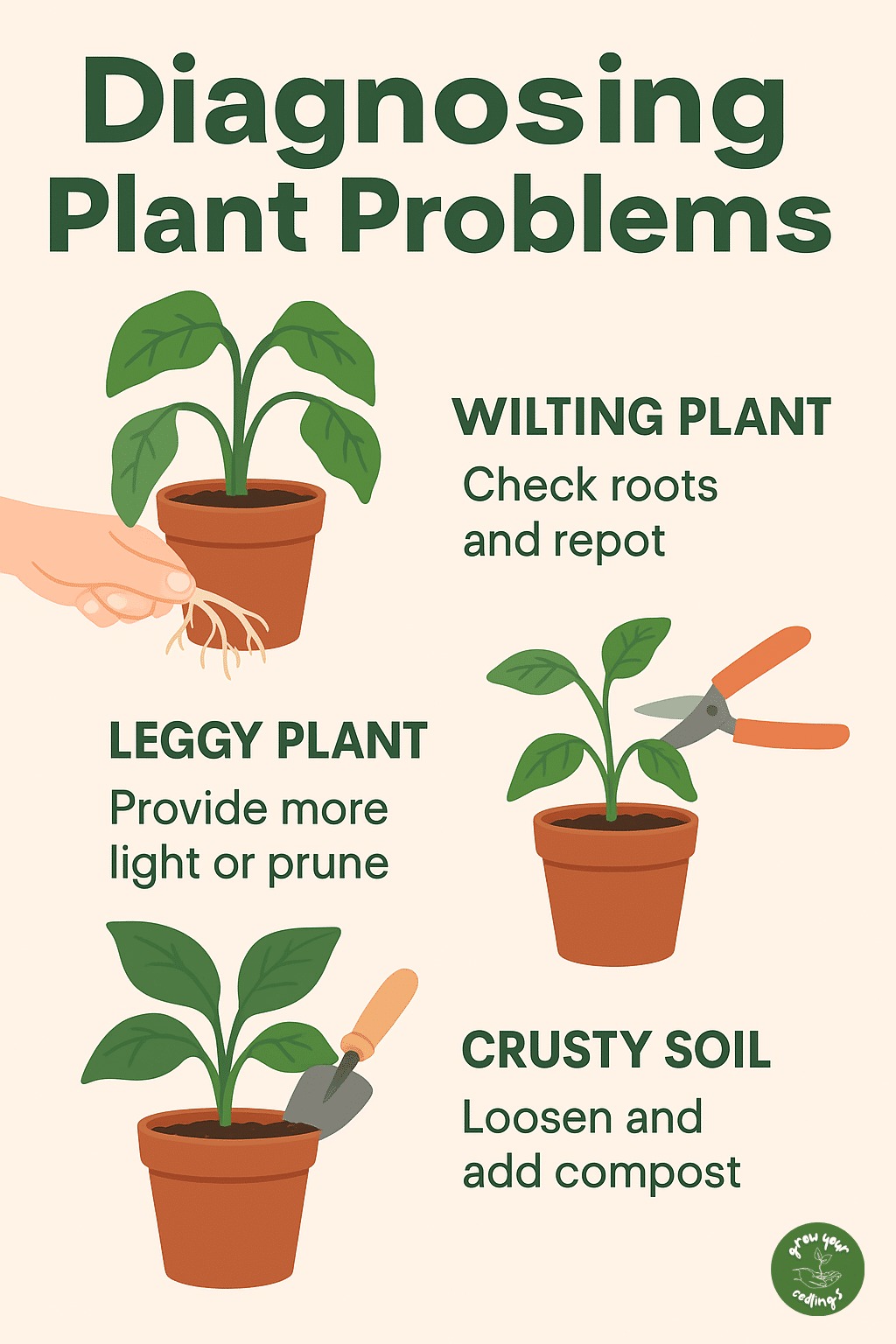Like many beginner gardeners, I started with more enthusiasm than know-how. I was living in Paris, eager to grow something of my own, and trying to be resourceful. I began by repurposing old furniture found in the street, turning drawers and boxes into makeshift planters. It felt clever and sustainable.
It was also a complete failure.
The untreated wood quickly rotted in the rain. None of the containers had drainage holes. I didn’t use a liner or geotextile fabric, so the soil compacted and water stagnated. The plants suffered, and I learned the hard way that gardening in pots for beginners isn’t just about enthusiasm — it’s about understanding a few basics that make all the difference.
This guide is designed to help you avoid the mistakes I made. Whether you’re working on a balcony, terrace, or small patio, container gardening is absolutely accessible — once you know how to start right.
Want to grow fresh food even without a garden ? 🌱
Get my PDF guide and discover how to grow delicious vegetables and herbs in any small space.

Grow Your Own Food Even Without a Garden – Free PDF
Choosing the Right Containers: The First and Most Important Step
Size: Let the Roots Breathe
One of the most common mistakes in gardening in pots for beginners is underestimating how much space roots need. Each plant has different needs:
- Herbs like parsley or basil do well in 5–10 liter pots.
- Cherry tomatoes need at least 20–30 liters.
- A pot that’s too small will cause roots to circle, dry out quickly, and limit plant health.
- A pot that’s too large may retain too much water and increase the risk of root rot — especially in seedlings.
Materials: Know Your Options
Terracotta or clay pots: A classic look and porous walls that allow good air circulation. Ideal for dry-loving plants like rosemary. Downsides: heavy, fragile, and they dry out fast.
Plastic or resin pots: Lightweight, inexpensive, and retain moisture well — a good option for herbs or thirsty plants. Can heat up in full sun but is great in partial sun !
Wooden planters: Natural and insulating. Must be made from treated wood or lined with a geotextile bag (with holes) to prevent rotting. I learned this the hard way after my first DIY planters decayed in just weeks.
Fabric grow bags: Affordable, breathable, and great for root development due to “air pruning.” Excellent for beginners, and easy to store off-season.
Metal containers: Trendy and durable, but they heat up quickly in the sun and can cause roots to overheat.
Raised garden beds: Larger containers, often made of wood or metal, ideal for growing a mix of herbs, greens, or flowers. They offer more space but still require good drainage and quality soil.

Drainage: Non-Negotiable
No matter what pot you choose, it must have drainage holes at the bottom. Without them, water accumulates, roots suffocate, and your plant suffers.
Place a layer of gravel or clay pebbles at the bottom before adding soil to improve drainage and aeration.
Soil and Substrate: What You Put In the Pot Matters
Garden soil from the ground is too heavy and often full of pests or weed seeds. For gardening in pots for beginners, the best choice is a high-quality potting mix.
- Use a light, well-draining mix designed for containers.
- You can enrich it with compost if available, or mix in perlite or coconut fiber to improve texture.
- Refresh your soil each season, or top up with compost if reusing.
Soil Maintenance Over Time
Another mistake I made early on was reusing old potting mix without refreshing it. While it’s fine to reuse soil between growing seasons, it must be replenished:
- Remove roots and debris after harvesting or replacing a plant.
- Add fresh compost or potting mix each season to replace depleted nutrients.
- If the soil has become compacted or soggy, consider mixing in fresh perlite or coir to improve texture and drainage.
For plants that live in the same pot year-round (like rosemary or perennials), top-dressing — replacing the top 5–10 cm of soil with fresh compost — is a good way to feed the plant without disturbing the roots.
Improving the Mix: DIY Tweaks
Even a good store-bought potting mix can be improved:
- Compost: Adding a small amount of mature compost (if available) can increase microbial activity and long-term fertility.
- Perlite or pumice: These lightweight minerals improve aeration and drainage, especially useful if your pots are in a humid climate.
- Coconut coir or peat moss: These materials help retain moisture and lighten the mix.
- Worm castings: If you have access to vermicompost or community compost bins (like I do in Paris), mixing in a handful of worm castings can provide a powerful nutrient boost.
Natural Kitchen Hacks for the Garden : Waste That Feeds Your Plants
If you’re just getting into gardening in pots for beginners, it’s worth knowing that some everyday kitchen scraps can improve your soil — when used properly and in moderation.
- Crushed eggshells: A great source of calcium. Rinse, dry, crush finely, and mix into the soil or sprinkle on top. They break down slowly and help prevent blossom-end rot in tomatoes.
- Used coffee grounds: Rich in nitrogen. Sprinkle lightly into your potting mix or compost pile — but don’t overdo it, as they can make soil too acidic in large amounts.
- Banana peels: High in potassium and phosphorus. Chop into small pieces and bury near the root zone of flowering plants. They break down gradually and promote blooming.
- Vegetable cooking water (cooled and unsalted): Can be used to water plants occasionally — it contains trace nutrients.
These additions won’t replace a complete composting system, but they’re an easy, beginner-friendly way to make your soil more nutritious using what you already have at home.
I’ve also made a video about choosing the right pots as a beginner — 15 hacks and ideas.
In this video, I share practical tips on selecting the best containers, soil, and plants so you can grow fresh food anywhere — even in a small space. Watch it here:
Beginner-Friendly Plants: Grow with Confidence
Herbs: Easy, Useful, and Rewarding
Start with these culinary classics:
- Basil (likes sun, dislikes cold)
- Mint (grows fast, invasive — plant alone)
- Parsley and chives (low maintenance, great in shade or partial sun)
Vegetables: Fast-Growing and Fun
Choose compact, productive varieties:
- Radishes: Quick to harvest and ideal for shallow pots.
- Lettuce or cut-and-come-again greens: Perfect for repeated harvests.
- Cherry tomatoes: Grow vertically with support, love the sun, and are extremely satisfying.
Flowers: Colorful and Beginner-Friendly
Add visual joy and attract pollinators with:
- Marigolds
- Geraniums
- Petunias
These are hardy, bloom generously, and require little maintenance.

Everyday Care: Build the Right Habits
Watering: Get the Basics Right
This is where most new gardeners go wrong. Here’s what works:
- Stick your finger into the soil — if it’s dry up to the first knuckle, it’s time to water.
- Water deeply, less frequently, rather than shallow, frequent watering. Deep watering encourages strong root growth.
- In hot months, pots may need watering every day, especially small or terracotta containers.
Light and Placement
Observe your space throughout the day:
- Full sun (6+ hours/day): Tomatoes, basil, most flowers.
- Partial shade: Mint, lettuce, parsley.
Matching plant needs to actual light exposure is one of the keys to success in gardening in pots for beginners.
Fertilizing
Potted plants can’t access nutrients beyond their container, so feeding them is crucial:
- Use a liquid organic fertilizer (like seaweed or compost tea) every 3–4 weeks during the growing season.
- For slow-release options, add solid organic pellets at planting time.
Common Problems and How to Solve Them
Yellow Leaves
Often caused by overwatering or poor drainage. Check that your pot drains properly and let the soil dry out slightly between waterings.
Wilting Despite Moist Soil
This might mean root rot. Take the plant out, inspect the roots — if they’re brown and mushy, trim the damaged parts and repot in dry, well-aerated soil.
Pests (like aphids or spider mites)
Spray plants with black soap diluted in water, or use a gentle mix of neem oil and water. Also, inspect the underside of leaves regularly.
Mold or Fungus on Soil
Likely due to poor air circulation or excessive moisture. Remove the top layer of soil, improve airflow, and reduce watering frequency.
Leggy Plants
Usually caused by insufficient sunlight. Move the pot to a brighter location and consider pinching back the stems to encourage bushier growth.

Essential Gardening Tips for Success
Start small. A few pots are better than trying too much at once.
Label your plants, especially herbs — it helps you learn and avoids confusion.
Observe regularly. The best gardening habit is simply to check in daily: touch the soil, look at the leaves, adjust as needed.
Be patient. Growth takes time. Not every plant will thrive, and that’s okay.
Celebrate small wins. Your first harvest — even a handful of parsley — is worth being proud of.
Cherish your gardening tools. Care extends their life. A well-kept tool works harder, and so do you.
Gardening in pots for beginners is not about doing everything perfectly — it’s about learning, adapting, and enjoying the process. You don’t need a garden to be a gardener. Whether you’re growing herbs for your kitchen, tomatoes for your salads, or flowers for joy, containers can open up a whole world of satisfaction.
The most important step? Just begin.
🌿 Join Our Balcony Gardening Community !
Share your balcony garden progress, get feedback from other urban gardeners, and discover new ideas every week.

